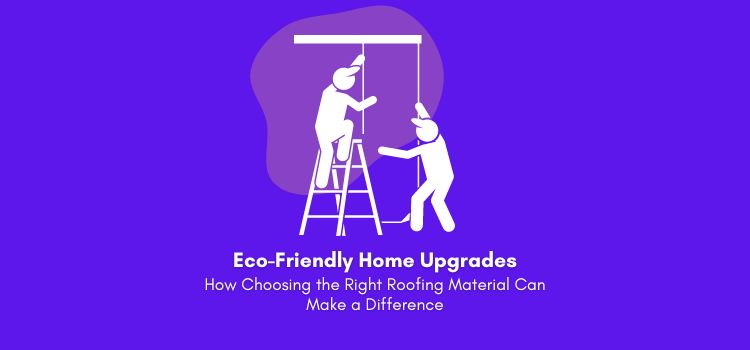In the era of sustainability, homeowners are increasingly looking for ways to make their living spaces more eco-friendly. From solar panels to energy-efficient appliances, the push towards green living is more prominent than ever. However, one aspect of eco-friendly home upgrades that often goes overlooked is the choice of roofing material.

Selecting the right roofing material can impact a home’s energy efficiency and overall environmental footprint. As we delve into the importance of roofing choices in sustainable living, it’s worth noting the expertise of industry professionals like those at a family-owned and operated company that specializes in eco-conscious roofing solutions.
The Significance of Eco-Friendly Roofing
Roofing is integral to how eco-friendly a home is and its effect on the environment, even though it may not be the first aspect that comes to mind. Commonly used roofing materials are functional but need more efficiency and sustainability in certain key ways. They tend to absorb a great deal of heat, leading to increased use of air conditioning and higher overall energy consumption for the home.
Their production and disposal processes can also negatively impact the environment. The roof is the top part of a building, so it is continuously exposed to the sun’s rays. Traditional materials trap this heat, causing inside temperatures to rise. Homeowners then rely more on air conditioning to cool indoor air. This extra use of air conditioning equipment uses up more electricity over time.
Additionally, the manufacturing and later removal of standard roofing choices involve hazardous substances that release harmful emissions or cannot decompose naturally. With some research and possibly more cost, homeowners have greener alternatives that lessen these issues and help create a more eco-friendly structure.
Eco-friendly roofing materials consider sustainability during their design. By reflecting more sunlight, they help decrease energy usage for cooling homes. This translates to lower electricity bills for homeowners. Additionally, many roofing options contain recycled content or are made from renewable resources.
Using post-consumer or post-industrial scrap reduces environmental waste. Choosing these responsible materials for one {roof can meaningfully lessen a homes carbon footprint. Individuals’ conscientious choices, when taken together, contribute positively to global ecological concerns. With a small amount of research, any homeowner can select a roofing type to lower their residence’s environmental impact.
The Benefits of Eco-Friendly Roofing Materials
Sustainable roofing materials provide several advantages, both environmental and financial. Primarily, they can significantly decrease a home’s energy usage by enhancing insulation and reflecting sunlight, thus helping to keep the home cooler in summer and warmer in winter. This reduces dependence on heating and cooling systems and leads to considerable cost savings on utility bills.
Roofing with eco-friendly materials has additional benefits. It protects natural resources and reduces greenhouse gas emissions that harm the environment. Opting for renewable roofing options shows commitment to energy efficiency and supports industries that lessen human impact on the planet. Overall, sustainable roofing proves a wise investment that returns financial and environmental benefits for many years.
Furthermore, there are several eco-friendly roofing alternatives produced using recycled materials, decreasing the requirement for fresh resources and also the environmental damage related to their removal and processing. These options tend to last longer than standard materials, causing fewer roof replacements through the lifetime of a home and thereby reducing waste.
Options including these recycled materials not only benefit the environment by lowering pollution and conserving natural resources but they also cut expenses for homeowners from infrequent replacement needs. Their extended lifespan in comparison to traditional roofing translates to lower costs of installation and less disruption that comes with replacement—overall, utilizing products made from post-consumer or post-industrial scrap proves kinder to the planet and our budgets.
Choosing the Right Roofing Material
Homeowners have various possibilities when choosing eco-friendly materials for their roofs. One option is metal roofing, which is extremely long-lasting and can be recycled. It reflects sunlight well, making it a superb pick for energy efficiency. Green roofs, covered with plants, not only supply outstanding insulation but also help lessen stormwater runoff and better air quality.
While solar tiles cost more, they can create electricity, substantially decreasing a home’s energy needs. Green roofs and solar tiles provide additional benefits beyond just protecting the house. Though metal and solar roofing have higher initial prices than traditional asphalt shingles, their durability and energy savings could result in long-term cost-effectiveness.
There are several vital factors for homeowners to take into account when selecting a roofing material for their home. The climate where one lives, along with one’s budget and desired visual style, are key considerations. Consulting with an experienced roofing contractor that focuses on environmentally-friendly options can offer useful guidance.
Speaking with such professionals will help homeowners understand which materials are a good fit based on their sustainability aims and will best suit the characteristics of their roof and local weather conditions. Choosing the right product with guidance from a knowledgeable roofing company can provide peace of mind that the selected solution aligns well with one’s goals for reducing their home’s environmental impact.
Conclusion
Transitioning to more environmentally friendly living habits is crucial, given the pressing need to reduce humanity’s footprint. The selection of roofing plays an important role, as eco-friendly options provide considerable advantages concerning energy use, environmental protection, and cost.
By educating themselves on roofing alternatives, homeowners can aid the planet’s well-being and benefit personally from a dwelling that is greener and more financially sensible over the long run. While changes take effort, selecting a sustainable roof serves our world’s current and future inhabitants.